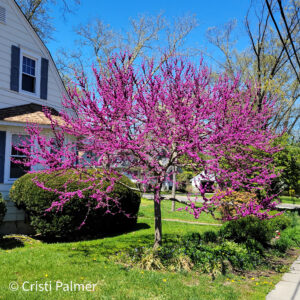Plant Information

The eastern redbud or American redbud,also known as Cercis canadensis, is a deciduous woody perennial in the Fabaceae family that is native to eastern North America. The genus name comes from the Greek kerkis meaning weaver’s shuttle, which refers to the shape of the seed pod.
The Eastern redbud can be identified by its showy pink flowers blooming in spring before its heart-shaped foliage emerges. Cultivars have blooms that range from white to deep purplish pink. This spring bloom attracts many pollinators like butterflies and bees, and the bean-like seed pod provides food for songbirds in the summer. The seed pod may also persist throughout winter and will release its seeds through the decaying of the fruit walls. Seeds are usually dispersed in fall and winter by wind and animals.
Eastern redbuds should be grown in average, medium moisture, well-drained soils in full or partial sunlight, with partial shade being best in hotter climates. It can grow in hardiness zones 4 to 8 in a wide pH range, but it does best where the pH is around 7.5. With good conditions and adequate watering, this low maintenance tree can grow to about 20 to 30 feet.
Historically the bark of eastern redbud has been used as an astringent in the treatment of dysentery and Native Americans have used the bark, roots, and inner bark to treat whooping cough, fevers, congestion, and vomiting. The flowers are edible and have been included in salads or eaten fried, and green twigs are sometimes used as seasoning for wild game.
Economics
According to the USDA NASS Census of Horticulture, redbuds sold for a value of $27 million in 2014 and $28 million in 2019.
Main Diseases Problems
Eastern redbuds are susceptible to various fungal diseases: anthracnose, Cytospora canker, root and crown rot, Verticillium wilt, and leaf spots. It is also susceptible to vascular streak dieback.
Main Pest Problems
Eastern redbuds are targeted by: Asiatic oak weevils, borers, caterpillars, Japanese beetles, treehoppers, twospotted spider mites, scales, webworms, and whiteflies.
IR-4 Research
IR-4 has worked to develop efficacy information on Asian ambrosia beetles, a problem that affects eastern redbuds. Additionally, IR-4 has conducted 26 crop safety trials to determine if certain pesticide products cause any harm or leave unsightly residues on redbuds.
Authors
Laura Werner, IR-4 Environmental Horticulture Program Research Assistant
References
https://en.wikipedia.org/wiki/Cercis_canadensis
https://plants.ces.ncsu.edu/plants/cercis-canadensis/
https://www.missouribotanicalgarden.org/PlantFinder/PlantFinderDetails.aspx?kempercode=h550
https://www.srs.fs.usda.gov/pubs/misc/ag_654/volume_2/cercis/canadensis.htm
https://ipm.ucanr.edu/PMG/GARDEN/PLANTS/redbud.html
https://portal.ct.gov/CAES/Plant-Pest-Handbook/pphR/Redbud-Cercis
https://quickstats.nass.usda.gov/
